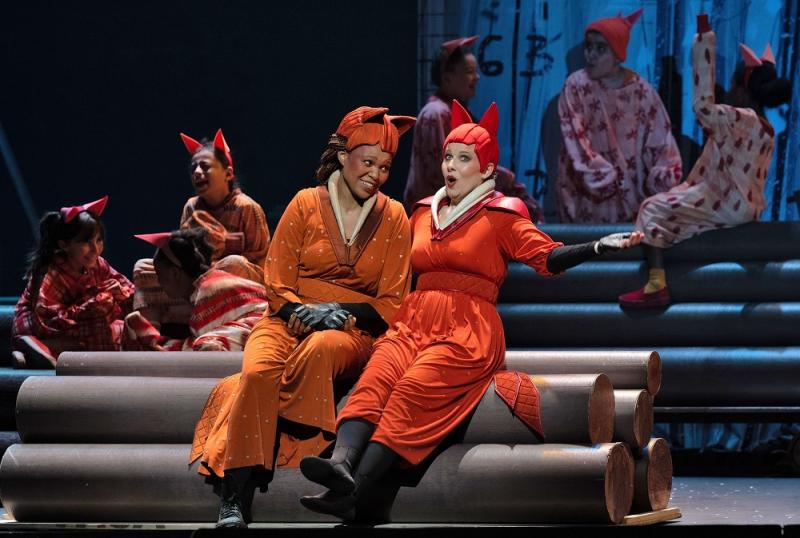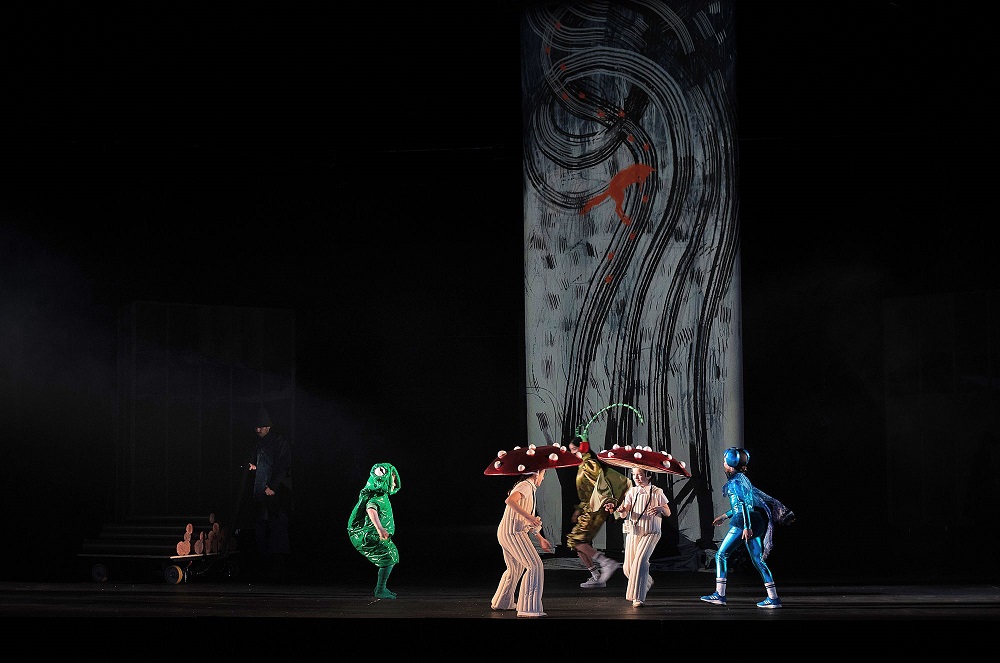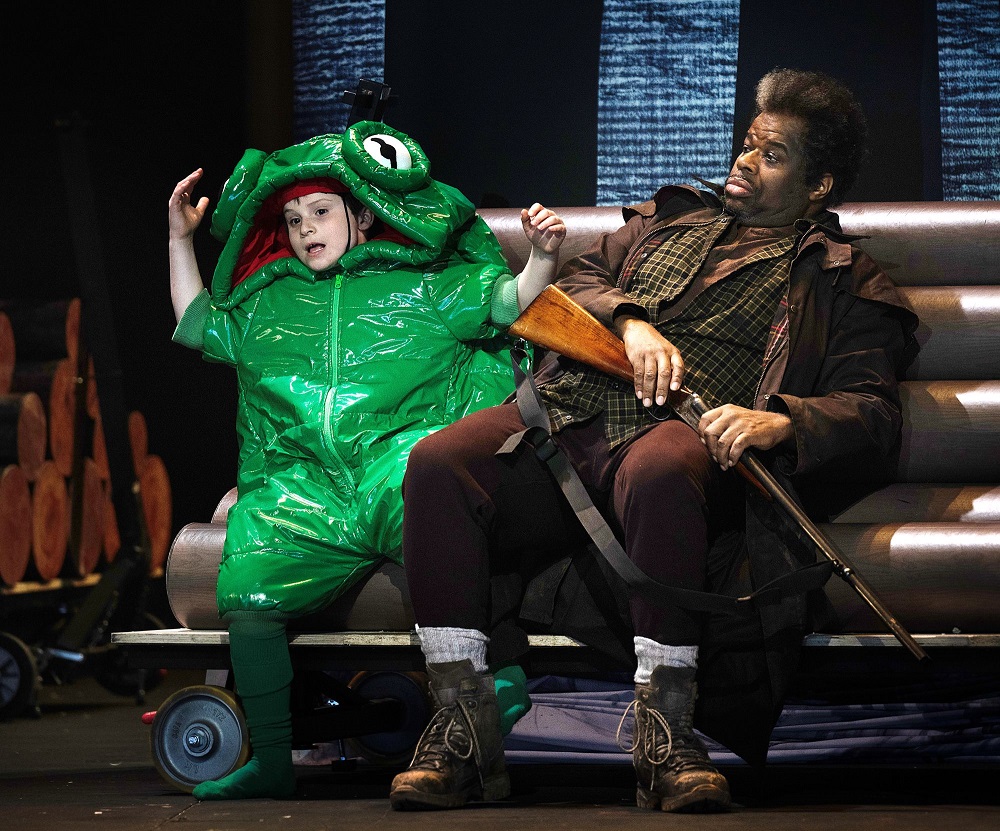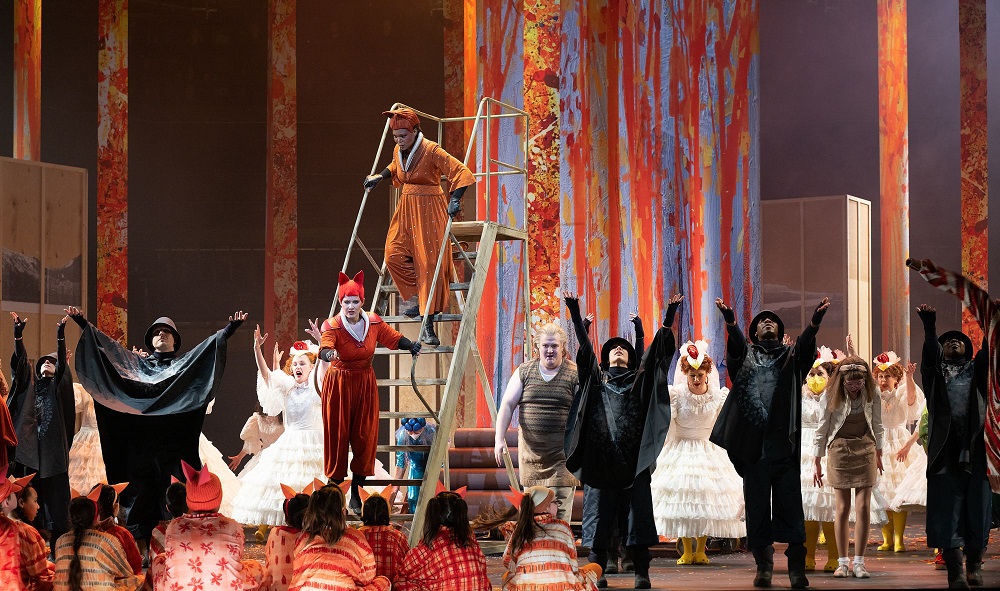The Cunning Little Vixen, English National Opera review - half-realised men and beasts | reviews, news & interviews
The Cunning Little Vixen, English National Opera review - half-realised men and beasts
The Cunning Little Vixen, English National Opera review - half-realised men and beasts
Lack of pace and focus can’t sink Janáček’s paean to the natural order

Nature in the form of Storm Eunice stopped this Cunning Little Vixen in her tracks on Friday evening. ENO shrugged off the cancellation and rescheduled for Sunday afternoon. And here we were, getting the essential message that humans must reach an accommodation with the natural world or die in despair. So much for a cute animal fable.
Director Jamie Manton understands the essence in the nearly-70-year-old Janáček’s fashioning of this trickiest-to-stage opera from Rudolf Těsnohlídek’s newspaper stories about a vixen with human qualities: in the composer’s own words, “I caught the Vixen for the forest and for the sadness of the late years”. Chief actor in the poetic realization of a fable that veers between vibrant youth and troubled old age is the artwork of Anya Allin on the rolling scroll that’s central to Tom Scutt’s ingenious designs (what fun the fly agaric mushrooms - two of them pictured below with other natural inhabitants and Allin's scroll- and Claire Barnett-Jones' Lapak the Dog must be having).. Allin takes us on a fabulous journey from the foetus in the womb to adulthood, a bright orange Munchian sun (colour-co-ordinated with the foxes, of course), winter, the sexagenarian decade and then beyond to transcendence.  Unfortunately the acting propensities of the scroll are much more focused than anything else on stage. After the brilliance of Brno National Opera director Jiří Heřman’s fantastical riff on life in the orphanage which Těsnohlídek set up in the country town of Bílovice nad Svitavou, much the best production of the Vixen I’ve ever seen, we’re back to kids and older actors in cutesy animal costumes: fine if they were more tautly choreographed. But there’s no real dance in Jenny Ogilvie’s movement direction other than the gestures of an ancient dragonfly (Joy Constantinides). Yes, we see younger incarnations of the leading human, the Forester, as well as of his catch the Vixen who later gets away, but the energy doesn’t flow evenly as it does in Janáček’s score.
Unfortunately the acting propensities of the scroll are much more focused than anything else on stage. After the brilliance of Brno National Opera director Jiří Heřman’s fantastical riff on life in the orphanage which Těsnohlídek set up in the country town of Bílovice nad Svitavou, much the best production of the Vixen I’ve ever seen, we’re back to kids and older actors in cutesy animal costumes: fine if they were more tautly choreographed. But there’s no real dance in Jenny Ogilvie’s movement direction other than the gestures of an ancient dragonfly (Joy Constantinides). Yes, we see younger incarnations of the leading human, the Forester, as well as of his catch the Vixen who later gets away, but the energy doesn’t flow evenly as it does in Janáček’s score.
Or ought to. And here, for me, is the most serious weakness of the evening. Martyn Brabbins treats the utterly original Janáček as if he were only one step on from Wagner – whose The Valkyrie Brabbins conducted so well earlier in the season. The score glows, but moves along so sluggishly that the singers have to declaim rather than dart more nimbly and speech-melodically around the orchestra (a poorly-stressed translation doesn't help). That almost works with Lester Lynch’s charismatic but too stentorian Forester (pictured below with Robert Berry-Roe's Frog) in the philosophy of the great final scene, but not elsewhere. The chorus aren’t the only participants who clearly want to move on faster than Brabbins is prepared to let them.  So Sally Matthews can’t be as agile as we – or presumably she – would like. More bounce would help get the words across, though vocally she’s radiant, and meshes well with another fine soprano, Pumeza Matshikiza, in the courtship scene of the Fox and the Vixen (but again, please, conductor, it’s not a Strauss duet).
So Sally Matthews can’t be as agile as we – or presumably she – would like. More bounce would help get the words across, though vocally she’s radiant, and meshes well with another fine soprano, Pumeza Matshikiza, in the courtship scene of the Fox and the Vixen (but again, please, conductor, it’s not a Strauss duet).
The Forester’s drinking companions the Priest and the Schoolmaster, ripe for disappointment, are vividly projected by Clive Bayley (doubling as the Badger evicted by the Vixen) and Alan Oke (also Mosquito). But Manton’s confusing idea to let the bridalwear hens be emancipated rather than despatched by the Vixen, and then to have them pose in brothel-boxes to hoodwink the drunken men as they head home defuses the idea that it's the woman-into-fox or vice-versa who becomes enmeshed in human fantasies. Didn’t work for me. The wedding celebration at the end of the Act Two is a blaze of colour, though, livened up by the introduction of the couple’s innumerable brood who usually only appear in the last act (scene pictured below).  Another kick into proper life comes in the shape of excellent young bass-baritone Ossian Huskinson’s poacher. But the accidental shooting scene is messy, like most of the ensemble business, and yesterday afternoon the oboe’s poignant reiteration of the Vixen’s “Wait until next May” theme after her death, failing to wait, wrecked the bittersweetness of the interlude. Still, the ending – a second death in the act, as Janáček implied – makes for the usual exultant tearfulness. The assorted children and adolescents, part of ENO Engage's work with Westminster primary schools, add huge fun and value to the whole experience. If you’re not too wide of the mark in terms of the big message, and Manton isn’t, then even a hazy execution can’t destroy it.
Another kick into proper life comes in the shape of excellent young bass-baritone Ossian Huskinson’s poacher. But the accidental shooting scene is messy, like most of the ensemble business, and yesterday afternoon the oboe’s poignant reiteration of the Vixen’s “Wait until next May” theme after her death, failing to wait, wrecked the bittersweetness of the interlude. Still, the ending – a second death in the act, as Janáček implied – makes for the usual exultant tearfulness. The assorted children and adolescents, part of ENO Engage's work with Westminster primary schools, add huge fun and value to the whole experience. If you’re not too wide of the mark in terms of the big message, and Manton isn’t, then even a hazy execution can’t destroy it.
The future of Arts Journalism
You can stop theartsdesk.com closing!
We urgently need financing to survive. Our fundraising drive has thus far raised £49,000 but we need to reach £100,000 or we will be forced to close. Please contribute here: https://gofund.me/c3f6033d
And if you can forward this information to anyone who might assist, we’d be grateful.

Subscribe to theartsdesk.com
Thank you for continuing to read our work on theartsdesk.com. For unlimited access to every article in its entirety, including our archive of more than 15,000 pieces, we're asking for £5 per month or £40 per year. We feel it's a very good deal, and hope you do too.
To take a subscription now simply click here.
And if you're looking for that extra gift for a friend or family member, why not treat them to a theartsdesk.com gift subscription?
more Opera
 La bohème, Opera North review - still young at 32
Love and separation, ecstasy and heartbreak, in masterfully updated Puccini
La bohème, Opera North review - still young at 32
Love and separation, ecstasy and heartbreak, in masterfully updated Puccini
 Albert Herring, English National Opera review - a great comedy with depths fully realised
Britten’s delight was never made for the Coliseum, but it works on its first outing there
Albert Herring, English National Opera review - a great comedy with depths fully realised
Britten’s delight was never made for the Coliseum, but it works on its first outing there
 Carmen, English National Opera review - not quite dangerous
Hopes for Niamh O’Sullivan only partly fulfilled, though much good singing throughout
Carmen, English National Opera review - not quite dangerous
Hopes for Niamh O’Sullivan only partly fulfilled, though much good singing throughout
 Giustino, Linbury Theatre review - a stylish account of a slight opera
Gods, mortals and monsters do battle in Handel's charming drama
Giustino, Linbury Theatre review - a stylish account of a slight opera
Gods, mortals and monsters do battle in Handel's charming drama
 Susanna, Opera North review - hybrid staging of a Handel oratorio
Dance and signing complement outstanding singing in a story of virtue rewarded
Susanna, Opera North review - hybrid staging of a Handel oratorio
Dance and signing complement outstanding singing in a story of virtue rewarded
 Ariodante, Opéra Garnier, Paris review - a blast of Baroque beauty
A near-perfect night at the opera
Ariodante, Opéra Garnier, Paris review - a blast of Baroque beauty
A near-perfect night at the opera
 Cinderella/La Cenerentola, English National Opera review - the truth behind the tinsel
Appealing performances cut through hyperactive stagecraft
Cinderella/La Cenerentola, English National Opera review - the truth behind the tinsel
Appealing performances cut through hyperactive stagecraft
 Tosca, Royal Opera review - Ailyn Pérez steps in as the most vivid of divas
Jakub Hrůša’s multicoloured Puccini last night found a soprano to match
Tosca, Royal Opera review - Ailyn Pérez steps in as the most vivid of divas
Jakub Hrůša’s multicoloured Puccini last night found a soprano to match
 Tosca, Welsh National Opera review - a great company reduced to brilliance
The old warhorse made special by the basics
Tosca, Welsh National Opera review - a great company reduced to brilliance
The old warhorse made special by the basics
 BBC Proms: The Marriage of Figaro, Glyndebourne Festival review - merriment and menace
Strong Proms transfer for a robust and affecting show
BBC Proms: The Marriage of Figaro, Glyndebourne Festival review - merriment and menace
Strong Proms transfer for a robust and affecting show
 BBC Proms: Suor Angelica, LSO, Pappano review - earthly passion, heavenly grief
A Sister to remember blesses Puccini's convent tragedy
BBC Proms: Suor Angelica, LSO, Pappano review - earthly passion, heavenly grief
A Sister to remember blesses Puccini's convent tragedy
 Orpheus and Eurydice, Opera Queensland/SCO, Edinburgh International Festival 2025 review - dazzling, but distracting
Eye-popping acrobatics don’t always assist in Gluck’s quest for operatic truth
Orpheus and Eurydice, Opera Queensland/SCO, Edinburgh International Festival 2025 review - dazzling, but distracting
Eye-popping acrobatics don’t always assist in Gluck’s quest for operatic truth

Add comment